One of the goals of homeschooling is to educate the whole child, not just the intellectual mind. For example, a child who may have some difficulty spelling may be a gifted handworker. A child who can easily read well beyond her years may have challenges comprehending math.
Traditional school models often focus on the intellectual center alone to the detriment of other ways of learning. Thus, if a child is gifted, but in an unaddressed center of intelligence, s/he may feel as if s/he is an underachiever.
One of benefits of homeschooling is that I am able to find the strengths and interests of Sophia and Olivia, and then allow them to develop new and existing skills fully. To do this, the girls need to be exposed to and have the ability to explore as many different centers of learning and ability as possible.
Sophia needlepointing a coaster.
As a first project, she worked with plastic.
However, subsequent projects are done with needlepoint canvas.
Working with yarn - or doing handiwork of any nature - requires developing hand/eye intelligence skills. Even playing a musical instrument or making art requires great dexterity and control in the hand/eye center.
On a practical level, being able to mend a sweater or work with tools (such as a tapestry needle or crochet hook) are basic life skills which a child's education should address.
Having the skill to manipulate yarn, needles, and/or other materials or tools helps gives the girls a feeling of mastery and control in their environment. Knowing how to make and change things to suit their needs and ideas fosters in them the idea that they can change their world.
Handwork builds self-reliance into the girls' lives. They are gaining more confidence knowing that they have the skills to make the things they want to play or work with, or that they need.
Olivia making a needlepointed coaster.
Working on a project that she could use
when it was finished helped keep her motivated.
The girls also enjoy doing tactile activities. They enjoy working with their hands and making something that is useful.
Handwork is also a great therapy in life when times are challenging. Being able to do needlepointing or crocheting can help a child stay busy, productive, and centered during any number of circumstances that are beyond their control.
Sophia knitting with Eenie on her lap.
When selecting yarn with which to work, it is important to select high-quality wools, cottons, and natural fibers.
At a class I taught at the homeschool co-op,
I showed the girls and other children the differences
between natural and synthetic yarn.
At times, the girls have used synthetic yarn a few times for practice. However, their final projects are always made yarn from natural sources. Having them work with these type of materials helps them develop their sense of touch and esthetic preferences.
Sophia showing a crocheted rug she made for her dolls.
This was her first crocheting project.
Educator Rudolf Steiner felt that natural materials, which have been alive, actually strengthen our etheric energy bodies, unlike synthetics, which cause the etheric energy to diminish. More information about Rudlolf' Steiner's view of handwork and knitting can be found on this informative website.
In addition to handwork, the girls also use yarn for other everyday projects. One of the things each of the girls made this past spring was a nesting container for the birds. They filled each empty suet holder with wool yarn, sheep wool, horse hair, and other natural nesting materials they could find.
Olivia creating a nesting container for the birds.
She used wool yarn as well as other natural items.
The birds would visit the containers and pull out things they wanted to add to their nests. Although we never saw where the yarn or wool was used, we hoped these items provided a comfortable nest for the baby birds and their mother.
We also enjoy seeing yarn incorporated into projects or at places where we've traveled. A couple of years ago, we traveled to Pella, Iowa, with the girls' grandparents, and visited the historical village there.
In one of the buildings, there was a bike that had crocheted wheel covers. In the Netherlands, It was common to decorate one's bike tires. We have never seen crocheted wheel covers in the United States, so this was interesting to see how other cultures and countries use yarn.
Crocheted bike cover.
Earlier this month, we traveled to New England to study six states as part of a multi-year, multi-disciplinary unit study. In New Hampshire, we visited the Enger Shaker Museum in New Hampshire.
When we toured the museum, we saw examples of handwork there - including rugmaking, spinning, and knitting. The basket below with yarn was sitting by the window.
A basket of yarn and tools at the
Enger Shaker Museum in New Hampshire.
Working with yarn and creating a variety of practical, useful items has been one of the components of homeschooling. Each year, I hope to have the girls continue learning and developing their skills in this area as well as discover new places where yarn and handwork is being displayed.

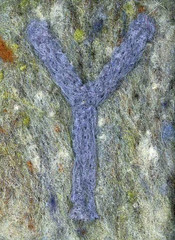
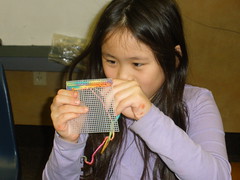

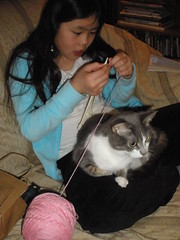

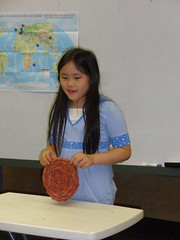
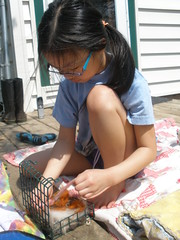

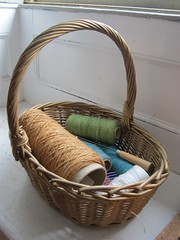
2 comments:
Y is for Yarn is definitely my favorite letter!! :)
Great Y! My Mom taught me how to crochet when I was a little girl. I haven't done it in a LONG time though. My boys may or may not like it; I should let them try it and see. They both enjoy woodworking. I love feeling the differences in the different yarns. The "real" stuff is definitely nicer to touch.
Post a Comment